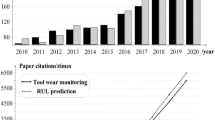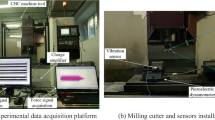Abstract
When the turning tool has worn and failed but the failure is not found, if it continues to be used for processing, it will break, and cause the workpiece to be scrapped, and even damage the machine tool. In order to avoid the loss caused by turning tool wear, the remaining useful life (RUL) prediction of turning tool wear has become a hot research topic in recent years. For RUL prediction in turning tools, the traditional machine is difficult to acquire sufficient degradation data and inconsistent data distribution among different turning tools in engineering, and they cannot provide better prediction accuracy to some extent. To solve the above problems, this paper proposes a multi-granularity feature extraction (MGFE) method based on the gray-level co-occurrence matrix (GLCM) and random forest (RF). Moreover, a health indicator (HI) of turning tools in the source domain was obtained. The common representative features in HI sequence of target domain was transferred to source domain and builds the condition monitoring and life prediction system of turning tools based on extreme learning machine and transfer learning. Finally, extreme vector machine (ELM) is used to construct the RUL prediction model. The research results show that the model constructed in this paper is effective in RUL prediction and can significantly improve the prediction accuracy of remaining useful life.









Similar content being viewed by others
References
Karandikar JM, Abbas AE, Schmitz TL (2014) Tool life prediction using Bayesian updating. Part 2: turning tool life using a Markov Chain Monte Carlo approach. Precis Eng 38(1):18–27
Yin Z, Huang C, Yuan J et al (2015) Cutting performance and life prediction of an Al2O3/TiC micro–nano-composite ceramic tool when machining austenitic stainless steel. Ceram Int 41(5):7059–7065
Karandikar JM, Abbas AE, Schmitz TL (2014) Tool life prediction using Bayesian updating. Part 1: milling tool life model using a discrete grid method. Precis Eng 38(1):9–17
Benkedjouh T, Medjaher K, Zerhouni N et al (2015) Health assessment and life prediction of cutting tools based on support vector regression. J Intell Manuf 26(2):213–223
Krolczyk GM, Nieslony P, Legutko S (2015) Determination of tool life and research wear during duplex stainless steel turning. Arch Civ Mech Eng 15(2):347–354
Qin Yi, **ang S, Chai Yi, Chen H (2020) Macroscopic-microscopic attention in LSTM networks based on fusion features for gear remaining life prediction. IEEE Trans Ind Electron 67(12):10865–10875
Dong M, He D (2007) A segmental hidden semi-Markov model (HSMM)-based diagnostics and prognostics framework and methodology. Mech Syst Signal Process 21(5):2248–2266
Shen ZJ, Chen XF, He ZJ et al (2013) Remaining life predictions of rolling bearing based on relative features and multivariable support vector machine. J Mech Eng (in Chinese) 49(2):183–189
Mao W, He J, Zuo MJ (2019) Predicting remaining useful life of rolling bearings based on deep feature representation and transfer learning. IEEE Trans Instrum Meas PP(99):1–1
Mosallam A, Medjaher K, Zerhouni N (2016) Data-driven prognostic method based on Bayesian approaches for direct remaining useful life prediction. J Intell Manuf 27(5):1037–1048
Shihab SK, Khan ZA, Mohammad A et al (2014) A review of turning of hard steels used in bearing and automotive applications. Prod Manuf Res 2(1):24–49
Kim DM, Bajpai V, Kim BH et al (2015) Finite element modeling of hard turning process via a micro-textured tool. Int J Adv Manuf Technol 78(9–12):1393–1405
Ahmadzadeh F, Lundberg J (2014) Remaining useful life estimation. Int J Syst Assur Eng Manag 5(4):461–474
Gupta MK, Sood PK (2017) Surface roughness measurements in NFMQL assisted turning of titanium alloys: an optimization approach. Friction 5(2):155–170
Das SR, Dhupal D, Kumar A (2015) Study of surface roughness and flank wear in hard turning of AISI 4140 steel with coated ceramic inserts. J Mech Sci Technol 29(10):4329–4340
Kumar R, Sahoo AK, Mishra PC et al (2018) Comparative investigation towards machinability improvement in hard turning using coated and uncoated carbide inserts: part I experimental investigation. Adv Manuf 6(1):52–70
Mia M, Dhar NR (2017) Optimization of surface roughness and cutting temperature in high-pressure coolant-assisted hard turning using Taguchi method. Int J Adv Manuf Technol 88(1–4):739–753
Leo Kumar SP, Jerald J, Kumanan S et al (2014) A review on current research aspects in tool-based micromachining processes. Mater Manuf Process 29(11–12):1291–1337
Fernández-Valdivielso A, López de Lacalle LN, Urbikain G et al (2016) Detecting the key geometrical features and grades of carbide inserts for the turning of nickel-based alloys concerning surface integrity. Proc Inst Mech Eng Part C J Mech Eng Sci 230(20):3725–3742
Bensouilah H, Aouici H, Meddour I et al (2016) Performance of coated and uncoated mixed ceramic tools in hard turning process. Measurement 82:1–18
Gupta M, Kumar S (2015) Investigation of surface roughness and MRR for turning of UD-GFRP using PCA and Taguchi method. Eng Sci Technol Int J 18(1):70–81
Madariaga A, Esnaola JA, Fernandez E et al (2014) Analysis of residual stress and work-hardened profiles on Inconel 718 when face turning with large-nose radius tools. Int J Adv Manuf Technol 71(9–12):1587–1598
Frangopol DM, Soliman M (2016) Life-cycle of structural systems: recent achievements and future directions. Struct Infrastruct Eng 12(1):1–20
Javed K, Gouriveau R, Zerhouni N et al (2014) Enabling health monitoring approach based on vibration data for accurate prognostics. IEEE Trans Ind Electron 62(1):647–656
Sun S, Brandt M, Mo JPT (2014) Evolution of tool wear and its effect on cutting forces during dry machining of Ti–6Al–4V alloy. Proc Inst Mech Eng Part B J Eng Manuf 228(2):191–202
Khorasani AM, Yazdi MRS (2017) Development of a dynamic surface roughness monitoring system based on artificial neural networks (ANN) in milling operation. Int J Adv Manuf Technol 93(1–4):141–151
Pervaiz S, Rashid A, Deiab I et al (2014) Influence of tool materials on machinability of titanium-and nickel-based alloys: a review. Mater Manuf Process 29(3):219–252
Suresh P, Marimuthu K, Ranganathan S et al (2014) Optimization of machining parameters in turning of Al–SiC–Gr hybrid metal matrix composites using grey-fuzzy algorithm. Trans Nonferrous Met Soc China 24(9):2805–2814
Guo L, Lei YG, Li NP et al (2018) Machinery health indicator construction based on convolutional neural networks considering trend burr. Neurocomputing 292(31):142–150
Liu Z, Zuo MJ, Qin Y (2016) Remaining useful life prediction of rolling element bearings based on health state assessment. Proc Inst Mech Eng C J Mech Eng Sci 230(2):314–330
Wu Y, Yuan M, Dong S, Lin L et al (2018) Remaining useful life estimation of engineered systems using vanilla lstm neural networks. Neurocomputing 275:167–179
Deutsch J, He D (2017) Using deep learning-based approach to predict remaining useful life of rotating components. IEEE Trans Syst Man Cybern Syst 48(1):11–20
Reshef DN, Reshef YA, Finucane HK et al (2011) Detectingnovel associations in large data sets. Science (New York, NY) 334(6062):1518–1524
Acknowledgements
Information of funding: Subsidized by Chongqing Basic Science and Research Project (cstc2015jcyjbx0133), National Natural Science Foundation of China (NSFC 51375519), National Natural Science Foundation of China (NSFC 51975078).
Author information
Authors and Affiliations
Corresponding authors
Additional information
Publisher's Note
Springer Nature remains neutral with regard to jurisdictional claims in published maps and institutional affiliations.
Rights and permissions
About this article
Cite this article
Gao, Z., Hu, Q. & Xu, X. Condition monitoring and life prediction of the turning tool based on extreme learning machine and transfer learning. Neural Comput & Applic 34, 3399–3410 (2022). https://doi.org/10.1007/s00521-021-05716-1
Received:
Accepted:
Published:
Issue Date:
DOI: https://doi.org/10.1007/s00521-021-05716-1




